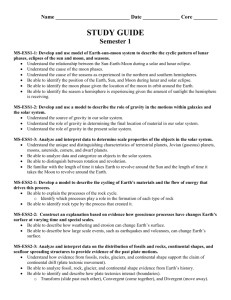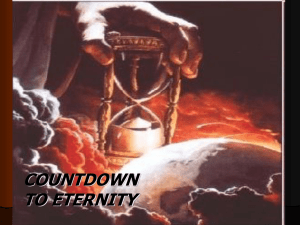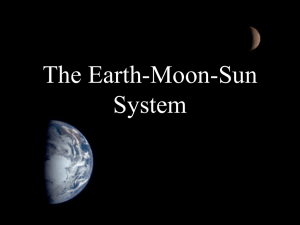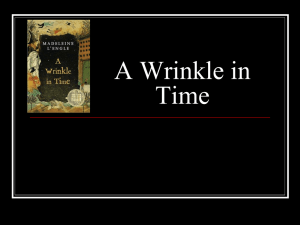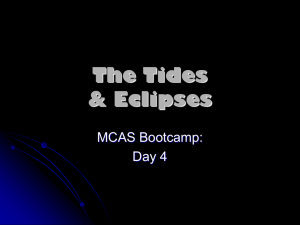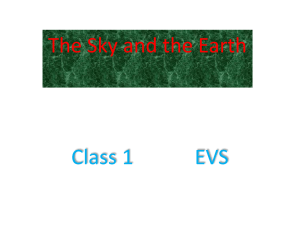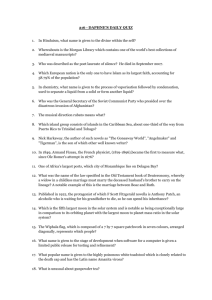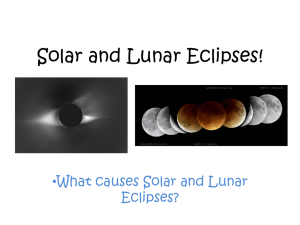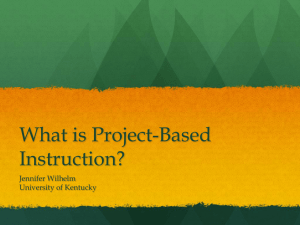File
advertisement
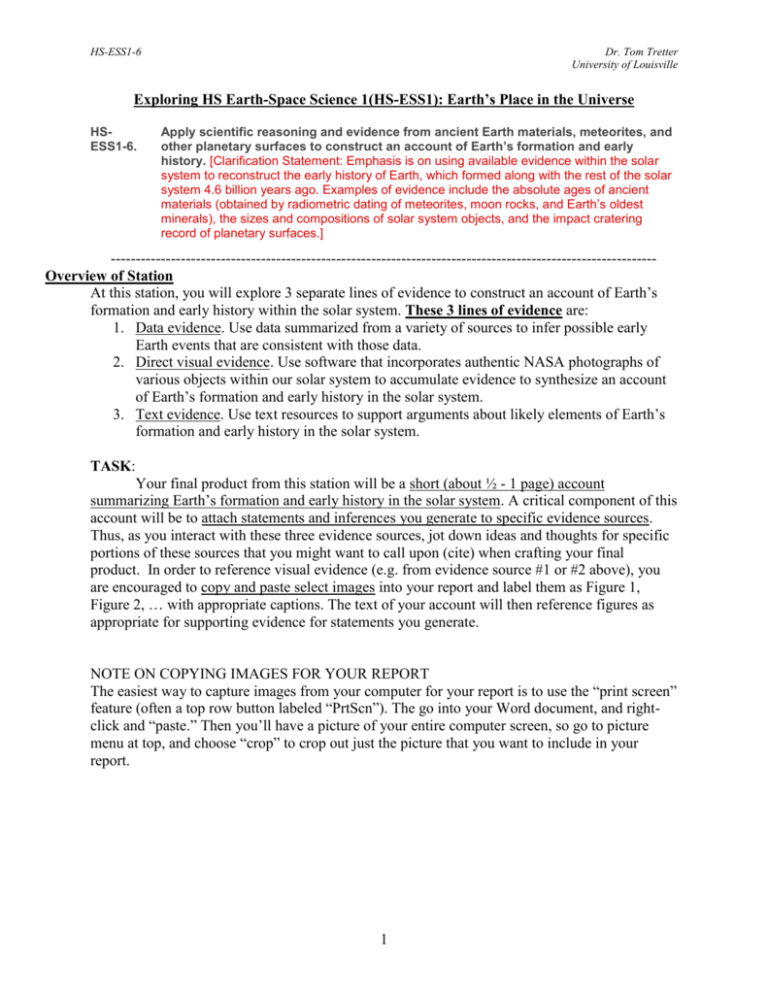
HS-ESS1-6 Dr. Tom Tretter University of Louisville Exploring HS Earth-Space Science 1(HS-ESS1): Earth’s Place in the Universe HSESS1-6. Apply scientific reasoning and evidence from ancient Earth materials, meteorites, and other planetary surfaces to construct an account of Earth’s formation and early history. [Clarification Statement: Emphasis is on using available evidence within the solar system to reconstruct the early history of Earth, which formed along with the rest of the solar system 4.6 billion years ago. Examples of evidence include the absolute ages of ancient materials (obtained by radiometric dating of meteorites, moon rocks, and Earth’s oldest minerals), the sizes and compositions of solar system objects, and the impact cratering record of planetary surfaces.] ------------------------------------------------------------------------------------------------------------Overview of Station At this station, you will explore 3 separate lines of evidence to construct an account of Earth’s formation and early history within the solar system. These 3 lines of evidence are: 1. Data evidence. Use data summarized from a variety of sources to infer possible early Earth events that are consistent with those data. 2. Direct visual evidence. Use software that incorporates authentic NASA photographs of various objects within our solar system to accumulate evidence to synthesize an account of Earth’s formation and early history in the solar system. 3. Text evidence. Use text resources to support arguments about likely elements of Earth’s formation and early history in the solar system. TASK: Your final product from this station will be a short (about ½ - 1 page) account summarizing Earth’s formation and early history in the solar system. A critical component of this account will be to attach statements and inferences you generate to specific evidence sources. Thus, as you interact with these three evidence sources, jot down ideas and thoughts for specific portions of these sources that you might want to call upon (cite) when crafting your final product. In order to reference visual evidence (e.g. from evidence source #1 or #2 above), you are encouraged to copy and paste select images into your report and label them as Figure 1, Figure 2, … with appropriate captions. The text of your account will then reference figures as appropriate for supporting evidence for statements you generate. NOTE ON COPYING IMAGES FOR YOUR REPORT The easiest way to capture images from your computer for your report is to use the “print screen” feature (often a top row button labeled “PrtScn”). The go into your Word document, and rightclick and “paste.” Then you’ll have a picture of your entire computer screen, so go to picture menu at top, and choose “crop” to crop out just the picture that you want to include in your report. 1 HS-ESS1-6 Dr. Tom Tretter University of Louisville STATION 1 – Data Evidence for HS-ESS1-6 The most direct source of non-Earth evidence for early solar system geology are the 381kg of moon rocks brought back by the Apollo program in late 1960s-1970s. These rocks have proved to be invaluable in deciphering the geologic evolution of the Moon. The Moon is a valuable source of early solar system evidence since the Moon is geologically inactive (no plate tectonics which subsume crust and destroy early evidence) and has no atmosphere, hence no erosion due to weathering. Other sources of evidence about lunar geology come from Earth-based telescopes and orbiting spacecraft. SURFACE COMPARISONS Lunar geology tends to cover two broad areas of study: Lunar Highlands and Lunar Lowlands. Lunar rocks are in large part made of the same common rock forming minerals as found on Earth, such as olivine, pyroxene, and plagioclase feldspar (anorthosite). Olivine basalt collected by Apollo 15 Relative Concentration (in weight %) of Various Elements on Lunar Highlands, Lunar Lowlands, and Earth 2 HS-ESS1-6 Dr. Tom Tretter University of Louisville GLOBAL COMPARISONS Lunar Prospector (1998-1999) was a mission was designed for a low polar orbit investigation of the Moon, including mapping of surface composition and possible polar ice deposits, measurements of magnetic and gravity fields, and study of lunar outgassing events. The Lunar Prospector Gamma Ray Spectrometer produced the first global measurements of gamma-ray spectra from the lunar surface, from which are derived the first "direct" measurements of the chemical composition for the entire lunar surface. These data effectively maps the distribution of various important elements across the Moon. For example, the Lunar Prospector GRS has identified several regions with high iron concentrations. Thorium concentrations on the Moon, as mapped by Lunar Prospector The most important elements detectable by the GRS were uranium (U), thorium (Th), and potassium (K), radioactive elements which generate gamma rays spontaneously, and iron (Fe), titanium (Ti), oxygen (O), silicon (Si), aluminum (Al), magnesium (Mg), and calcium (Ca), elements which emit gamma rays when hit by cosmic rays or solar wind particles. However, regardless of what causes them, gamma rays for each element are all different from one another - each produces a unique spectral "signature," detectable by an instrument called a spectrometer. ------------------------------------------Summary of estimated global compositions (rather than just rocks on surface) of Earth and Moon for select key elements: In this composition table, note the two largest discrepancies, and connect those to the image below comparing the large-scale structure of Earth and Moon. 3 HS-ESS1-6 Dr. Tom Tretter University of Louisville 4 HS-ESS1-6 Dr. Tom Tretter University of Louisville STATION 2 – Direct Visual Evidence for HS-ESS1-6 You will use the NASA website “Eyes on the Solar System” http://eyes.nasa.gov/ to visually explore the solar system. NOTE 1: This website is a 3-D visual environment full of real NASA mission data, including actual photographs of solar system objects; these are not artists’ renditions. NOTE 2: The software to run the visualizations (Unity 3D plugin) at this site requires a download the first time you use it. -------------------------------------------------------------------------------------------NAVIGATING a. Click “Intro” video to get an overview. b. After “Intro” video, you may also want to click “Tutorials” and then “Eyes…Basics” to get a more detailed overview of navigating within this program. These two resources should be enough to get you started. c. Then back on main page, click “Launch” to get started. d. HELP – bottom right has question mark “help page” with lots of good details about controls if needed. e. NOTE: One useful feature you may overlook the first time… In right hand vertical icon menu, there is a “lighting” toggle that lets you illuminate the entire object whether it is in the Sun or not. Useful to see things in the dark! -------------------------------------------------------------------------------------------TASKS 1. Fly to Earth. Orbit around a bit, noting global physical features. This serves as a sort of reference point for comparing physical features of other solar system objects. 2. Fly to Moon. Orbit around a bit, noting global physical features. Noting that, from solar system perspective, the Moon is a very close neighbor of Earth, how might that proximity relate to ideas about early Earth formation & history in solar system? Jot observations for how Moon physical features are same/different from Earth. Also feel free to note any questions or wonderings you might have related to this visual evidence in terms of Earth formation & early solar system history. 3. Fly to Mercury. Document same sort of ideas as you did for Moon. 4. Fly to Venus. Document same sort of ideas as you did for Moon. 5. Fly to Mars. Document same sort of ideas as you did for Moon. For fun, you might want to zoom in on Curiosity. 6. In the “Destination” menu (bottom left), click on “Asteroids” and visit the following: Vesta (2nd largest asteroid – we have a mission on the way there now) 2012 DA14 (close flyby in 2013) Apophis (2029 encounter) 7. Fly to Jupiter’s moon Callisto, then to Jupiter’s moon Europa. Document same sort of ideas as you did for Moon. 5 HS-ESS1-6 Dr. Tom Tretter University of Louisville STATION 3 – Text Evidence for HS-ESS1-6 6
